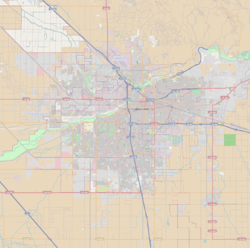East Bakersfield
East Bakersfield is a region in Bakersfield, California directly east of downtown. The region was formerly known as the town of Sumner, which was later incorporated and renamed Kern City. It is primarily a mixture of residential and commercial developments. It also contains a small business district (which was the downtown for Kern City) centered on the intersection of Baker and Sumner streets. Census data is provided on the right for the time period when the region was an independent town and city. It is part of the Bakersfield urban area of almost 500,000 people.
East Bakersfield | |
|---|---|
 East Bakersfield Location within Bakersfield | |
| Coordinates: 35°22′59″N 118°59′6″W | |
| Country | United States |
| State | California |
| County | County of Kern |
| City | City of Bakersfield |
| Founded | 1876 |
| Incorporated | 1892 |
| Annexed | 1910 |
| Subdistricts of East Bakersfield | List
|
| Area | |
| • Total | 4.00 sq mi (10.4 km2) |
| ZIP Code | 93305 |
| Area Code | 661 |
The area known as East Bakersfield includes land that is both part of Bakersfield city limits and unincorporated areas. The unincorporated area's population is approximately 55,000, and has large Hispanic and African American populations. The major school districts in East Bakersfield are the Bakersfield City School District and the Kern Union High School District. East Bakersfield has four high schools, Highland High School, East Bakersfield High School Foothill High School, and Mira Monte High School.
History
| Historical population | |||
|---|---|---|---|
| Census | Pop. | %± | |
| 1880 | 242 | — | |
| 1890 | 622 | 157.0% | |
| 1900 | 1,291 | 107.6% | |
| US Census[1] | |||
In 1874, the Southern Pacific railroad was extended to the southern San Joaquin Valley. Bakersfield was positioned to be a whistle-stop, but a land dispute developed between the city and the railroad. Southern Pacific wanted two blocks of land from the city; Bakersfield was only willing to give one block. The result of the dispute was Southern Pacific building its tracks five miles east of Bakersfield and founding their own town. This town was called Sumner in honor of Joseph W. Sumner, mine owner and judge. It would eventually become East Bakersfield.[2]
A post office opened in Sumner in 1876.[3] Since the train went through Sumner, instead of Bakersfield, it was a serious competitor to the city. However, the citizens of Bakersfield rallied, and maintained a presence in their city.[2] By 1888, a street car line was built between Bakersfield and Sumner. The route was down 19th St., and was the only road that connected the two settlements.[4]
By 1892, Sumner, which was now known as Kern City, would incorporate into a city. The city of Bakersfield had disincorporated (or dissolved as a city) in 1876, but voted to reincorporate in 1898, and became a city again.[5] That same year, Bakersfield finally became its own whistle-stop with the building of the San Francisco and San Joaquin Railroad, which was later bought by Santa Fe.[6]
With the construction of the new railroad, the need for Kern City diminished. In 1910, Kern City voted to join Bakersfield.[7] It also became known as East Bakersfield. This was Bakersfield’s first major expansion outside its historic central area. Many of the city's transit locations were in East Bakersfield. These included a second fire station, another library (Baker Street Branch), and a new high school (East Bakersfield High School).
Old Town Kern
Old Town Kern is located primarily around Baker Street, and was the former central business district for the town of Sumner (which was later renamed Kern City). This was the location of the original train station in Bakersfield and competed to be the commercial downtown, eventually losing to the present location west of Old Town. This district is home to many Basque-cuisine restaurants.
See also
- Bakersfield, California
- Bakersfield (Southern Pacific station)
References
- Population Totals by Township and Place for California Counties: 1860 to 1950 Archived 2012-03-09 at the Wayback Machine. California Department of Finance. Accessed: 03-12-2012.
- Baily, Richard. Heart of the Golden Empire. Windsor Publications Inc, Woodland Hills, CA:1984. ISBN 0-89781-065-1. Pages 49-50.
- Durham, David L. (1998). California's Geographic Names: A Gazetteer of Historic and Modern Names of the State. Clovis, Calif.: Word Dancer Press. p. 997. ISBN 1-884995-14-4.
- Lynch, George.The Streetcars, Gone but not Forgotten Archived July 7, 2011, at the Wayback Machine. The Bakersfield Californian. Accessed: 05-14-2010.
- Baily, Richard. Heart of the Golden Empire. Windsor Publications Inc, Woodland Hills, CA:1984. ISBN 0-89781-065-1. Page 71.
- Maynard, John. Bakersfield, A Centennial Portrait. Cherbo Publishing Group Inc, Encino, CA:1997. ISBN 1-882933-19-2. Page 36.
- History of Bakersfield Archived January 9, 2012, at the Wayback Machine. City of Bakersfield. Accessed: 05-14-2010.